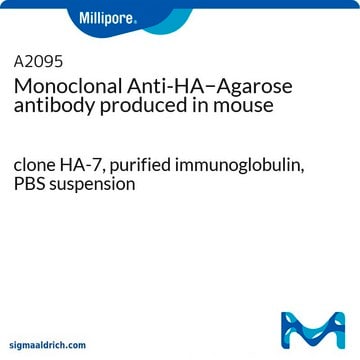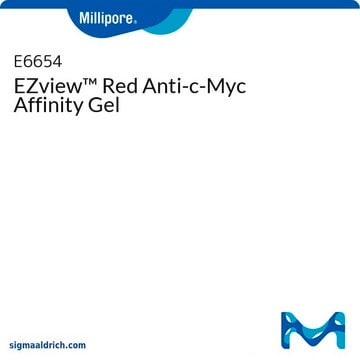IP0010
Anti-HA Immunoprecipitation Kit
Anmeldenzur Ansicht organisationsspezifischer und vertraglich vereinbarter Preise
Alle Fotos(1)
About This Item
UNSPSC-Code:
12352203
NACRES:
NA.56
Empfohlene Produkte
Antikörper-Produkttyp
primary antibodies
Klon
monoclonal
chemische Klasse(n) des Analyten
proteins (hemagglutinin)
Methode(n)
immunoprecipitation (IP): suitable
Lagertemp.
2-8°C
Verwandte Kategorien
Allgemeine Beschreibung
Anti-hemagglutinin (HA) Immunoprecipitation Kit is designed to recover maximum amounts of HA-tagged proteins in the immunoprecipitates. The process is carried out in mini-spin columns instead of microcentrifuge tubes to ensure easy washing of antigen-antibody-bound beads with minimal variability.
Anwendung
Anti- hemagglutinin (HA) Immunoprecipitation Kit has been used for immunoprecipitation. It has also been used in in vitro acetylation assay from human embryonic kidney cell lines.
Leistungsmerkmale und Vorteile
- Anti- hemagglutinin (HA) coupled beads enable high specific binding to HA-tagged fusion proteins
- Coupling of Anti-HA antibodies to the beads eliminates other preliminary and calibration steps
- Mini-spin columns enable the minimal loss of anti-HA-bound beads during washing
- The CelLyticTM M cell lysis reagent provides a high yield, rapid and efficient mammalian cell lysis
- Ready-to-use cell lysis reagent and 10X concentrated immunoprecipitation buffer
Not finding the right product?
Try our Produkt-Auswahlhilfe.
Lagerklassenschlüssel
10 - Combustible liquids
WGK
WGK 3
Flammpunkt (°F)
Not applicable
Flammpunkt (°C)
Not applicable
Analysenzertifikate (COA)
Suchen Sie nach Analysenzertifikate (COA), indem Sie die Lot-/Chargennummer des Produkts eingeben. Lot- und Chargennummern sind auf dem Produktetikett hinter den Wörtern ‘Lot’ oder ‘Batch’ (Lot oder Charge) zu finden.
Besitzen Sie dieses Produkt bereits?
In der Dokumentenbibliothek finden Sie die Dokumentation zu den Produkten, die Sie kürzlich erworben haben.
Kunden haben sich ebenfalls angesehen
Lin Jin et al.
PLoS pathogens, 12(5), e1005609-e1005609 (2016-05-19)
Bacterial AvrE-family Type-III effector proteins (T3Es) contribute significantly to the virulence of plant-pathogenic species of Pseudomonas, Pantoea, Ralstonia, Erwinia, Dickeya and Pectobacterium, with hosts ranging from monocots to dicots. However, the mode of action of AvrE-family T3Es remains enigmatic, due
Paola Krall et al.
PloS one, 5(9), e12859-e12859 (2010-09-30)
Mutations in the TRPC6 calcium channel (Transient receptor potential channel 6) gene have been associated with familiar forms of Focal and Segmental Glomerulosclerosis (FSGS) affecting children and adults. In addition, acquired glomerular diseases are associated with increased expression levels of
Satadru K Lahiri et al.
American journal of cancer research, 6(5), 910-923 (2016-06-14)
Krüppel-like factor 8 (KLF8) plays important roles in cancer and is strictly regulated by various post-translational modifications such as sumoylation, acetylation, ubiquitylation and PARylation. Here we report a novel phosphorylation of KLF8 by ERK2 responsible and critical for the stability
Xiaolong Tang et al.
Nature communications, 12(1), 5058-5058 (2021-08-27)
Dietary interventions such as intermittent fasting (IF) have emerged as an attractive strategy for cancer therapies; therefore, understanding the underlying molecular mechanisms is pivotal. Here, we find SIRT7 decline markedly attenuates the anti-tumor effect of IF. Mechanistically, AMP-activated protein kinase
Jian Sun et al.
The Journal of biological chemistry, 293(21), 8275-8284 (2018-04-08)
Connexin-43 (Cx43, also known as GJA1) is the most ubiquitously expressed connexin isoform in mammalian tissues. It forms intercellular gap junction (GJ) channels, enabling adjacent cells to communicate both electrically and metabolically. Cx43 is a short-lived protein which can be
Unser Team von Wissenschaftlern verfügt über Erfahrung in allen Forschungsbereichen einschließlich Life Science, Materialwissenschaften, chemischer Synthese, Chromatographie, Analytik und vielen mehr..
Setzen Sie sich mit dem technischen Dienst in Verbindung.












